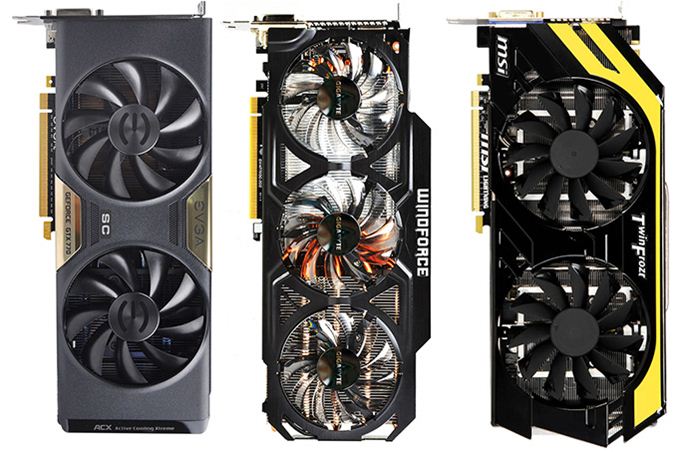The GeForce GTX 770 Roundup: EVGA, Gigabyte, and MSI Compared
by Ryan Smith on October 4, 2013 9:00 AM ESTFinal Words
Bringing this roundup to a close, as we mused about in the beginning the fact that the GeForce GTX 770 and its GK104 GPU is already being pushed close to its limits at stock puts NVIDIA’s partners in an interesting position. There’s still room for differentiation, but with NVIDIA having already extracted most of the clockspeed headroom of GK104 along with the memory bandwidth needs at these performance levels, GTX 770 requires that partners do more than just factory overclocks if they wish to stand apart from the crowd. The end result is that each card we’ve looked at today still comes with its own unique attributes – both good and bad – we just have to look a bit deeper than just price and performance to find them.
We’ll start then with the EVGA GTX 770 Superclocked ACX and the Gigabyte GTX 770 OC Windforce 3X since the cards are so similar. Both are currently priced at $399, the MSRP of the GTX 770 itself, offering a step up above the performance of the reference GTX 770 for no additional cost. The performance gains from their factory overclocks aren’t particularly notable, but at the same time all of this comes for free. Ultimately they’re functionally indistinguishable as far as performance is concerned, with Gigabyte’s slight overclock advantage making little difference.
As far as the hardware and its design considerations, we do finally see some interesting differences that set the cards apart. Both cards are using similar cooling principles – open air cooling – and both use it very effectively with GPU temperatures never exceeding the mid-60s under gameplay. However when it comes to noise Gigabyte has the edge, with their Windforce 3X equipped card producing around 3dB less noise under load than EVGA’s ACX cooler. If hardware performance is the most important consideration then this is a distinct advantage that tips the scales in Gigabyte’s favor.
On the software and support side however EVGA will have the edge. Gigabyte’s OC Guru II software and 3 year warranty are perfectly adequate, but they will fall short of EVGA’s excellent Precision X software and the options EVGA makes available for extended warranties and stepping up to other EVGA cards. A choice between the two ultimately comes down to Gigabyte’s acoustic advantage, or EVGA’s value added features.

On the other hand the MSI GTX 770 Lightning is something of the odd man out here. MSI has put quite a lot of effort into the design of their card in the name of chasing overclocking, and as a result the GTX 770 Lightning is quite the impressive card from a construction standpoint, clearly putting it a tier over cards like EVGA and Gigabyte’s designs. However since that enhanced overclocking functionality isn’t available without 3rd party modifications, the additional construction and customization MSI has gone through is lost on the average buyer, for whom asking to turn to 3rd parties is asking a bit much. Then again much like the construction of the card itself, one can certainly argue that the GTX 770 Lightning isn’t targeted at the average buyer either.
The out of the box experience in any case has the GTX 770 Lightning performing very similarly to the EVGA and Gigabyte cards, to no great surprise. The fact that MSI has built a card that gets to ship with higher TDP limits should not go unmentioned, as that’s one of the throttle points for the GeForce 700 series, but at the same time we realize that GTX 770 isn’t TDP throttling enough for that difference to manifest itself in the stock configuration. The end result being that MSI has put together a very good card that’s easily competitive with everything else we’ve seen, but without crossing the line into unofficial modifications, MSI's $35 price premium is hard to justify.
Otherwise at stock and within the official overclocking limits it’s a strong performer that never the less doesn’t appreciably distance itself from the likes of the Gigabyte GTX 770 Windforce 3X in either performance, overclocking headroom, or cooling performance. MSI’s best foot to put forward in this situation, like EVGA, is going to be their overclocking software, which also like EVGA remains the gold standard for overclocking software.










55 Comments
View All Comments
YazX_ - Sunday, December 8, 2013 - link
i'm not sure why he is getting this result on stock Gigabyte, mine boosts to 1257 MHz on stock, i pushed it to 1300 Mhz and OCed memory to 7.7 Ghz and its stable.Go6s - Monday, November 24, 2014 - link
I've got same results with my Gainwward GTX 770 ref, by tweaking bios.What voltage for 1257 stock ?
The Buggman - Sunday, January 19, 2014 - link
This has helped a lot in my quest for a new GPU. I think I've settled on the Gigabyte Windforce. However, I was a little confused by the listing. To ask plainly, if I was searching for this card to purchase, what would be the difference between the "OC Windforce" and the "OC Windforce OC?" It isn't an OC Windforce card you've gone and someway re-overclocked, is it?chegax - Saturday, March 29, 2014 - link
It only exist the "OC Windforce". This "OC" means that it has the multipliers unlocked. The last OC (OC Windforce "OC") means that they overclocked and made the benchmarks tests.Go6s - Monday, November 24, 2014 - link
Really nice !I just have one question.
In the grid, at line "Overclock Core Clock", these are max values to base voltage (1.100v) by tweaking bios ?